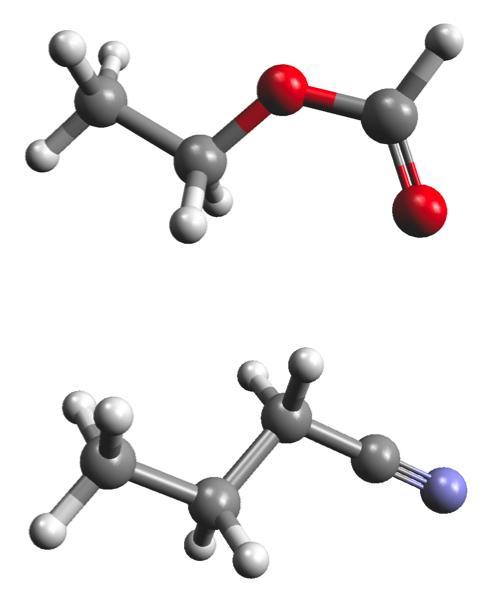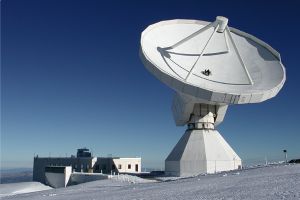These are ethyl formate and propyl cyanide products. The computational models regarding interstellar chemistry indicate that in addition to these two, even larger organic compounds may be found, including the amino acids that have not yet been discovered

Scientists from the Max Planck Institute for Radio Astronomy in Bonn (Germany), from Cornell University (USA) and the University of Cologne (Germany) have discovered two of the most complex organic compounds ever discovered in interstellar space: ethyl formate and propyl cyanide. Their computational models of interstellar chemistry indicate that in addition to these two, even larger organic compounds may be found, including the yet-to-be-discovered amino acids - those compounds that are essential to life.
A telescope in Spain (IRAM 30 m) was used to detect the emission of protos in the region where a star begins to form (Sagittarius B2), close to the center of our galaxy. The two mares were discovered within a hot, compressed cloud of gas known as the "Large Molecule Heimat" containing a radiant star that had formed a long time ago (in astronomical terms). Different types of organic compounds have already been discovered in this cloud in the past, including: salts, aldehydes and acids. The two new compounds - ethyl formate (ethyl formate, C2H5OCHO) and propyl cyanide (n-propyl cyanide, C3H7CN) represent two different types of compounds - esters and alkyl cyanides - which are the most complex yet discovered in interstellar space.

Atoms and particles emit radiation at unique wavelengths, which appear as characteristic "bands" in the electromagnetic spectrum of astronomical origin. Detecting the signature of Froda in this spectrum is similar to detecting a fingerprint in humans. "The difficulty in locating complex constellations lies in the fact that even the best astronomical sources contain so many different constellations that their "fingerprints" overlap and are difficult to identify," said Arnaud Belloche, a scientist from the Max Planck Institute and one of the authors of the article discussing this study. "It is even more difficult to identify large ferrets because their fingerprints are almost invisible: their emission is dispersed into many more bands that are weaker" adds one of the researchers. Out of 3700 spectral lines detected with this telescope, the team was able to identify 36 of them belonging to these two new species.
In the next step, the researchers used a computational model to understand the chemical processes that allowed the formation of other particles in space. Chemical reactions can result from collisions between gaseous particles; However, in space there are also tiny grains of dust scattered in the interstellar gas and these can serve as sites where atoms may react with each other to create larger particles. As a result, layers of ice accumulate on the nuclei, which consist mainly of water, but also contain several basic organic compounds such as: methanol - the simplest alcohol.
"However, it seems that larger particles are not formed in this way - atom by atom," explains one of the researchers. In contrast, the computational models imply that the more complex particles are formed segment by segment, using building blocks that were created earlier, such as the methanol that is already present on the dust grains. The computational models show that these segments, or "functional groups" can join together effectively to obtain a "chain" in a series of short steps. It seems that the two new mules that were discovered were created precisely by this method.
Adds one of the researchers: "There is currently no limit to the size of the particles that can be created in such a process - so there is good reason to expect the presence of even more complex organic particles - if we manage to locate them."
One of the main researchers believes that this will happen in the near future: "What we are doing now is like finding a needle in a haystack. More advanced instruments (such as the Atacama Large Millimeter Array) will be able to allow a more efficient examination for the detection of organic matter in interstellar space." It is possible that the sacrifice will even contain amino acids, which are required to create proteins, and are therefore essential for life on earth. In the past, attempts were made to locate the simplest amino acid, glycine (NH2CH2COOH), but it was never identified. However, the size and complexity of this froda can match the two new frodas discovered by the team. An article about this research was published in the scientific journal Astronomy & Astrophysics.
Sources:
In the same topic on the science website:

12 תגובות
The last anonymous user was me
I am a little less 🙂
: )
I too 🙂
Lol I loved.
I would like to raise an interesting hypothesis:
Is it possible that life was created after the two organic mares found two organic mares for them to get the first living thing? 🙂
charles,
Just a note. In the same way, it can provide the explanation of how they were formed under conditions, even of DHA, suitable for the creation of a planet with molecules that were the building blocks of life. This still does not require that it supports the theory that life is from extraterrestrial asteroids.
Intriguing... Maybe this could explain how life first formed on the surface of the Earth
The vegetarians would celebrate there.
Stunning !
Is it possible that amino acids are formed only in a sufficient gravity environment?
Sammy Colon:
It is a hot gas and it also emits radiation.
Here we are talking about the emitted radiation and this is also what is written in the original article
Thanks for the excellent article.
Please fix atoms and particles that absorb radiation, which is visible as streaks in the radiation that reaches us. and do not emit as written.